Digestive retention times for Allen’s swamp monkey and L’Hoest’s monkey: data with implications for the evolution of cercopithecine digestive strategy
作者机构:Department of AnesthesiaStanford University Medical CenterStanfordCaliforniaUSA Department of Ecological AnthropologyUniversity of Texas at San AntonioSan AntonioTexasUSA
出 版 物:《Integrative Zoology》 (整合动物学(英文版))
年 卷 期:2012年第7卷第2期
页 面:183-191页
核心收录:
学科分类:0710[理学-生物学] 07[理学] 0905[农学-畜牧学] 0906[农学-兽医学] 071002[理学-动物学]
主 题:Cercopithecinae digestive retention time evolution of diet fermentation plant fiber
摘 要:Primates access energy from plant fiber via bacterial fermentation in either a modified forestomach(‘foregut’),a caecocolic(‘hindgut’)chamber of the large intestine,or *** digestive retention times allow for more complete fermentation;as such,primates that consume an herbivorous diet high in fiber are expected to have both relatively and absolutely longer retention times than those mammals that rely on more readily digestible plant foods,such as *** used particulate markers to measure the digestive retention times of captive Allen’s swamp monkeys[Allenopithecus nigroviridis(Pocock,1907)](n=3)and L’Hoest’s monkey(Cercopithecus lhoesti ***,1899)(n=2).Results indicate mean retention times of 23.2-29.4 h and 23.2-24.0 h for *** and ***,*** from this study,in combination with previously published data on digestive retention times in other primate species,indicate that cercopithecines differ from other primate taxa by having lengthier retention times that can be predicted by body mass *** data are consistent with the hypothesis that relatively lengthy retention times are a primitive trait for Cercopithecinae.



